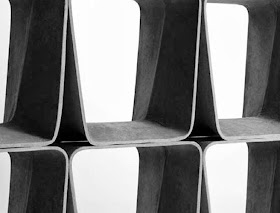ETERNIT ECAL STOOL & ECAL TABLE
DESIGN BY NICOLAS LE
MOIGNE
ECAL DESIGN BY NICOLAS LE MOIGNE
IN COLLABORATION WITH ETERNIT ( SCHWEIZ ) AG
Developed as part of the postgraduate study diploma of the ECAL /
University of Art and Design Lausanne, this project was conducted in
collaboration with the firm Eternit. For more than 100 years, this company has
been manufacturing flower pots, outdoor furniture and mainly architectural
elements with the material of the same name. “Eternit” is composed largely of
cement and of different fibres.
The project results from research into this material with a view to
finding new casting techniques. Numerous tests allowed different objects to be
developed to prototype stage, and some of these are now being produced and
marketed by the firm Eternit.
PROJECT DETAILS ECAL STOOL & ECAL TABLE 2007
Although Eternit is strong, it is necessary to find a way of rigidifying
the material using folds and reinforcements. After testing a number of shapes,
research finally led to the creation of a stool whose structure is reinforced
by a central fold. With this result proving satisfactory, a low table was then
designed on the same principle. These two objects are now being produced by the
firm Eternit and have been on sale since the beginning of the year.
Photo credits: ECAL /Thomas Adank
http://www.nicolaslemoigne.ch/en/
ECAL STOOL
A
'' I don' t want to shock but rather create something functional.''
NICOLAS LE MOIGNE
A
B
ECAL STOOL
ECAL TABLE
NICOLAS LE MOIGNE
Nicolas Le
Moigne’ s designs are a celebration of juxtaposition. They show an
understanding of, and capacity for, complexity and contrast: seemingly fragile
yet resilient, at once artisanal yet also industrial, assuredly sophisticated
yet without guile. Like a master swordsman he parries and ripostes between
opposing materials, forms and conventions to produce designs that are rigorous
and balances.
This
equanimity has brought the Swiss designer, a professor at ECAL / University of
art and design Lausanne, to the attention of both manufacturers and design
galleries alike. Working between industrial companies such as
Eternit, Atelier Pfister and gallerie in London, Paris, Berlin and
Mexico. Le Moigne’ s dexterous approach is an elegant counterpoint to the chaos
of a upersaturated design culture.
CAREER /
EDUCATION
Industrial
designer, ecal / ecole cantonale d’art de lausanne (2001-2007)
AREA OF
EXPERTISE
Master project
in collaboration with eternit (2007)
IMPORTANT
WORKS / PROJECTS
Trash cube
(hocker) for eternit (2011)
Le locle
(tisch), le day (kommode) und meyrin (regal) für atelier pfister (2010)
Slip stool,
for gallery libby sellers (2008)
Ecal stool
and table, for eternit (2007)
Verso
diverso, watering can for viceversa (2005)
Public clock,
for the city of geneva (2004)
Pot-au-mur,
flowerpot for serralunga (2003)
DISTINCTIONS
Bourses
fondation leenaards: lauréat (2009)
Swiss federal
design grant: lauréat (2008)
Design preis
schweiz: nominated (2008)
Macef design
award: winner (2005)


.jpg)
.jpg)




























.jpg)






























